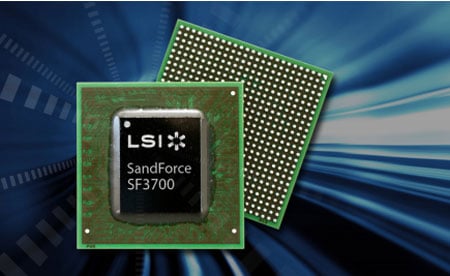LSI Introduces Blazing Fast SF3700 Series SSD Controller, Supports Both PCIe and SATA 6Gbps
Among other things, the SF3700 family is the industry's first flash controller to support both native PCI-E Gen2 x4 and SATA 6Gbps host interfaces in a single ASIC design. The upshot of integrating support for both interfaces in a single ASIC is that it simplifies the SSD design process and significantly reduces the development and manufacturing costs for SSD makers. Rather than develop two completely separate lines from start to finish and juggle different hardware, SSD makers can use a simple manufacturing jumper to select the final desired interface for better inventory and cost management, LSI says. What's more, the PCI-E interface supports both AHCI and NVMe protocols to enable both legacy applications of PCI-E flash and efficient NVMe flash storage application acceleration solutions.

For the end user, this should ultimately translate into lower cost SSDs, provided the savings in manufacturing get passed on to the consumer. Whether or not it plays out that way we'll have to wait and see.
There are other benefits as well. By adding PCI-E interface support, the SF3700 controller family can achieve over 1,800MB/s sequential read performance. That's three times faster compared to the prior generation SATA-based solutions, and unprecedented on the client side, LSI says.
"From our everyday lives to the hyperscale datacenter, flash storage solutions are transforming the speed and efficiency of data storage," said Huibert Verhoeven, vice president and general manager, Flash Components Division, LSI. "The SF3700 family brings a new architecture, designed from the ground up to deliver unmatched flash performance and the longevity required to drive current and future portable client computing, enterprise and big data applications."

Source: LSI
Early testing by LSI and third parties looks promising, if not exciting. On the SATA side of things, 256GB SSDs equipped with the SF3700 controller show sequential read and write performance in the neighborhood of 500MB/s and 550MB/s, respectively, as well as random write IOPS of 46,000 and random read IOPS of 94,000. Switching over to the PCI-E interface, consumer drives blaze a trail with 1,800MB/s of sequential read and write performance, along with 81,000 random write IOPS and 150,000 random read IOPS.
The SF3700 family consists of four tiers. They include:
- SF3719: Entry-level clients (SATA + x2 PCI-E)
- SF3729: Mainstream clients (SATA + x2 PCI-E)
- SF3739: Enthusiast Client and Value Enterprise (4x PCI-E)
- SF3759: Enterprise Caching and Enterprise Storage (Scalable PCI-E)
What's interesting here is that LSI has built a modular controller capable of supporting both consumer and enterprise products. Built from the ground up, the SF3700 controller sports interchangeable front-end, core, and back-end components. The front-end features the dual-interface design, while the core does most of the heavy lifting such as taking care of Garbage Collection, Intelligent Wear Leveling, encryption, and more. It's also home to LSI's DuraWrite technology as found on previous generation controllers.
Finally, the back-end interface has nine NAND channels and supports a whole bunch of different NAND configurations. Each of the eight primary NAND channels has its own dedicated sub-controller, as does the extra ninth-channel which allows drive makers to offer binary capacities such as 1TB instead of 960GB without tapping into the overprovisioned area.
SF3700 controllers are currently shipping to LSI's hardware partners. Expect to see SSDs using the new controller in the first half of 2014.


